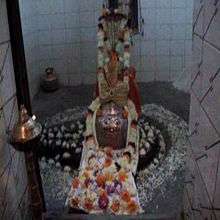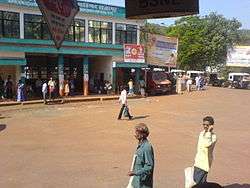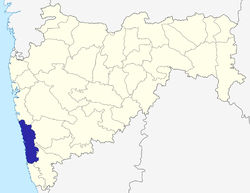Rajapur, Maharashtra
| Rajapur राजापुर | |
|---|---|
| City | |
|
Rajapur Central Depot | |
 Rajapur Location in Maharashtra, India | |
| Coordinates: 16°40′N 73°31′E / 16.67°N 73.52°ECoordinates: 16°40′N 73°31′E / 16.67°N 73.52°E | |
| Country |
|
| State | Maharashtra |
| District | Ratnagiri |
| Elevation | 72 m (236 ft) |
| Population (2001) | |
| • Total | 10,499 |
| Demonym(s) | Rajapurkar |
| Languages | |
| • Official | Marathi |
| Time zone | IST (UTC+5:30) |
| Telephone code | 2353 |
| ISO 3166 code | IN-MH |
| Vehicle registration | MH-08 |
Rajapur is a city and a municipal council in Ratnagiri district in the Indian state of Maharashtra. It is 385 km away from Mumbai.
Geography
Rajapur has an average elevation of 72 metres (236 feet).[1]
Demographics
As of 2001 India census,[2] Rajapur had a population of 10,499. Males constitute 50% of the population and females 50%. Rajapur has an average literacy rate of 78%, higher than the national average of 59.5%: male literacy is 82%, and female literacy is 74%. In Rajapur, 12% of the population is under 6 years of age.
History
During the days of the Bijapur Sultanate, Rajapur was important maritime trade centre due to a navigable creek that connects it to the Arabian sea. It became an access point to the rich cities of Deccan for those involved in the Arabia-India commerce.[3]
Doroji's attack on Rajapur
After defeating the Bijapuri general Afzal Khan, the Maratha king Shivaji entered the present-day Ratnagiri district and started capturing the important ports and towns. Many Bijapuri generals fled to Rajapur because its governor, known by the title Rustam-i-Zamani, was on friendly terms with Shivaji.[4]
However, Doroji, one of Shivaji's generals, attacked Rajapur. The East India Company had stationed several men in the town, under the charge of Henry Revington to facilitate the trade of saltpeter, pepper, calicoes and cotton. When Rustam-i-Zamani heard about the approach of the Maratha army, he procured funds from one of the Company's brokers and escaped with the money in a junk (ship). Revington sent an English ship Diamond to stop him. When confronted by the English, Rustam offered the company the ownership of two of his junks in lieu of payment. At the same time, the Marathas also arrived, and asked the English to hand over the junks to them. The English declined to oblige, unless they were given the money that Rustam owed them. The angry Marathas seized two of the Company's brokers, Baghji and Balaji, in Jaitapur. When the English sent Philip Gyffard to demand their release, he was arrested as well. The three prisoners were taken to Kharepatan fort on 18 January 1660.[4]
Henry Revington wrote to Shivaji in February 1660, requesting their release. Meanwhile, the brokers had also pleaded for their release, and Shivaji issued an order to set them free. Shivaji also condemned the attack on Rajapur, dismissed Doroji and issued an order to restore all the loot from Rajapur.[4] However, a rogue officer at Kharepatan refused to set Gyfford free unless he received a bribe. He decided to move Gyfford to another location, escorted by his small Maratha contingent. Revington dispatched an armed party that waylaid the contingent and rescued Gyfford by force.[4]
Shivaji's relations with the Company
The East India Company personnel at Rajapur maintained amicable relations with Shivaji until June 1660, when the Adilshahi general Siddi Jauhar attacked Shivaji's camp at Panhala. During this siege, Siddi Jauhar used grenades purchased from the English at Rajapur. He also hired some English artillerymen, who came to Panhala with an English flag, although the Company did not officially support him. Shivaji managed to escape from Panhala, and decided to take revenge as he assumed that the Company had supported Siddi Jauhar. He plundered the English factory at Rajapur in December 1661.
During the attack, Shivaji captured four Englishmen - Henry Revington, Richard Taylor, Randolph Taylor and Philip Gyffard - who were imprisoned, first at Vasota and later at Songd. Shivaji's officer Raoji Pandit treated them well, but the Marathas demanded ransom for their release. The English insisted that they had lost everything at Rajapur and would be unable to pay a ransom. Instead, they tried to negotiate their release in exchange for their support in capturing the Danda Rajpuri sea fort. This negotiation could not happen due to the absence of Shivaji, who was away on an expedition near Kalyan. The English prisoners wrote an angry letter to the Company's President, who replied that they had been imprisoned not for performing the Company duties, but for illegally supporting Siddi Jauhar without the Company's permission. Subsequently, the four made an escape attempt, but they were caught and moved to Raigad.
Later, Shivaji came to know that the Company had not officially supported Siddi Jauhar, and that some rogue personnel had joined Jauhar without the Company's permission. He ordered the release of the English prisoners in 1663. In a letter dated 6 February 1663, Shivaji also assured that the English would enjoy his protection in the future. The English informed him about the losses suffered by them at Rajapur, and tried to negotiate a settlement. In 1672, Shivaji offered them 5000 pagodas towards the losses. He also promised that if the English decided to set up a new factory at Rajapur, he would "show all kindness and civility imaginable to the said factory".[4]
Later developments
The English and French East India Companies had factories which were located near the creek. It is known that these factories were abandoned in the early 18th century and appear to be used later for offices (kacheris).
Rajapur is mentioned in novel Parashuramachi Savli by the Marathi author Ravindra Pinge.
Education
- Aacharya Narendra Dev Vidyamandir, Bhoo.
- Abbasaheb Marathe Arts & New Commerce Science College Affiliated to University of Mumbai.[5] Is one of the important higher educational institute, which is run by Rayat Shikshan Sanstha, Satara (Maharashtra).Abbasaheb Marathe Arts and New Commerce, Science College is established in 1994.[6] The college was initially run in the building of Navajeevan High-School, Rajapur and then shifted in its own building in January 8, 2001. This college was first started in Navajeevan High school since 1994 but now it is working in Vikhare Gothane which is the part of Rajapur Tahasil.
- Navajeevan High school is one of the well known high school and junior college in the Rajapur Tahasil.
- Rajapur High School is an old multi purpose High School and is situated in the heart of the town. It extends education in various subjects like drawing, carpentry, music, tailoring, commerce, typing, agriculture. Dadasaheb Mawlankar, first Speaker of Lok Sabha, Indian Parliament, was an alumnus of Rajapur High School. Two other institutions which are more than 100 years old are 'Rajapur Nagar Vachanalaya' i.e.library and Lakshmikeshav Aushadhalaya i.e. Ayurvedic pharmaceutical.
Places of interest

- Rajapur is a hub for business activity for the surrounding many small villages. Rajapur is famous for mangoes called Alphanso or locally called "Hapus".
- Aryadurga devi, Devihasol : Shri Aryadurga devi temple is very famous in Rajapur (Ratnagiri) Many devotees come to visit this temple. It is 24 km from Rajapur. The fair of Aryadurga devi is very famous in Rajapur
- Rajapurchi Ganga: At a distance of 2 kilometre from Rajapur, a holy place "Rajapurchi Ganga" i.e. Holy Ganges of Rajapur is wonder of nature. It is situated at a height 25 metres above height of Rajapur. This place is usually dry. However, all of a sudden water starts flowing in ponds. Barring exceptions, usually it happens once in 3 years. Small tanks are built for storing water and facilitating bathing. Surprisingly water temperature in these tanks is different from each other, though those are at distance of 1 metre from each other. Approximately after three months, water disappears or stops streaming. There is a local lore how & why Holy Ganges appeared at this place. Scientifically it could be a long siphon from Sahyadri range. Millions of people visit the Ganges for bathing. One of the bigger tank, 'Kashikund' delivers clean water like glass and people believe that bathing in this water will relieve them of sins.
- Hot Water Spring: At one kilometre distance from Jawahar Chouk, Rajapur, there is Hot Spring. This place is called "Unhala". Hot water of this spring is rich with Sulphur and famous for curing skin diseases.
- Dhoot Papeshwar Temple: Very old Lord Shiva Temple is situated at 1.5 kilometre Rajapur. There is a picturesque waterfall close to Dhootpapeshwar
- Mahakali Temple: Goddess Mahakali's temple is situated at Adiware Village, It is very old temple and is close to Rajapur that can be reached by car.
- Madban: At a distance of 38 km from Rajapur, and possessed of a good beach. Also there is a Bhagvati temple which is famous in Panchkroshi.
- Yeshwantgad, an island fortification.
- Vatul Village close to Mumbai Goa Highway. Swaymbhu Mahadev & Adhisthi Devi temples, Wandertek Sunset point, Vatul Dam
- Kankaditya Sun Temple: At a distance of approximately 30 km towards Ratnagiri on the Coastal Highway is one of the unique Sun Temples of India with a huge mandap supported only on the sides
- Harihareshwar Temple - Pangare Budruk Village: 10 km from Rajapur city. Adjoining to Swami Shivanand (Tembe maharaj) Ashram.
Gallery
 Shri Aryadurga devi devihasol. Shri Navadurga devi
Shri Aryadurga devi devihasol. Shri Navadurga devi Shri aryadurga devi devihasol
Shri aryadurga devi devihasol
References
- ↑ Falling Rain Genomics, Inc - Rajapur
- ↑ "Census of India 2001: Data from the 2001 Census, including cities, villages and towns (Provisional)". Census Commission of India. Archived from the original on 2004-06-16. Retrieved 2008-11-01.
- ↑ Marguerite Eyer Wilbur (1951). The East India Company: And the British Empire in the Far East. Stanford University Press. p. 173. ISBN 978-0-8047-2864-5. Retrieved 13 February 2013.
- 1 2 3 4 5 Shivaji and the English in Western India by Jadunath Sarkar, in The Journal of the Bihar Research Society (p. 418-427)
- ↑ http://www.erayat.org/amcr/1.1.htm
- ↑ http://www.erayat.org/amcr/

